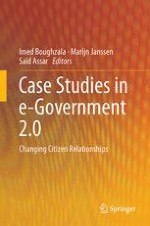
2015 | OriginalPaper | Buchkapitel
1. E-Government 2.0: Back to Reality, a 2.0 Application to Vet
verfasst von : Imed Boughzala, Marijn Janssen, Saïd Assar
Erschienen in: Case Studies in e-Government 2.0
Aktivieren Sie unsere intelligente Suche, um passende Fachinhalte oder Patente zu finden.
Wählen Sie Textabschnitte aus um mit Künstlicher Intelligenz passenden Patente zu finden. powered by
Markieren Sie Textabschnitte, um KI-gestützt weitere passende Inhalte zu finden. powered by